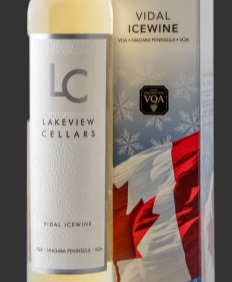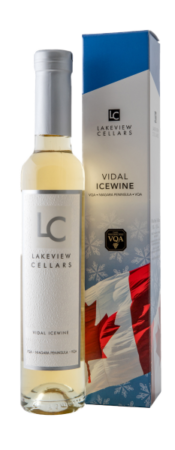
Understanding Icewine: Demystifying a uniquely Canadian beverage
By submitted by Lakeview Wine Co.
Processing Food Trends Beverages
NIAGARA-ON-THE-LAKE, Ont.—Canada is renowned around the world for it, but to many here at home, Icewine remains a bit of mystery.
Deeply coloured, sweet and uniquely Canadian, Icewine is made possible because of the perfect growing conditions in the summer in its various wine regions, and the harsh cold of a Canadian winter. While oenophiles (wine connoisseurs) around the world clamour for it, Canadians have a bit more trepidations in approaching the skinny bottle that doesn’t look quite like anything else on the shelves at the liquor store. Questions are raised about how it should be stored, the correct serving temperature, pouring etiquette, proper glassware and what foods should be paired with it.
“More traditional table wines may be more common in Canadian wine fridges, but there is a lot to enjoy from the wines that are made from grapes picked in the dead of winter,” said Gillian Minaker, sommelier at Lakeview Wine Co., a division of Diamond Estates Wine & Spirits. “Canadian Icewines boast rich flavours and offer fantastic pairing opportunities.”
Making Icewine is a detailed and complex process that starts during harvest when the winemaker decides which grapes are going to be left on the vine until winter’s deep freeze hits. There they will stay until late December or January—exactly when they are picked is determined by Mother Nature when she graces the vineyard with three or four days where the temperature stays below -8°C. The grapes, which now resemble little purple marbles, are hand-picked and pressed while frozen to extract a small amount of sweet, concentrated grape juice—typically yielding about 15 per cent of what those grapes would have produced had it been picked during harvest.
After a short fermentation process—due to naturally high sugar levels—a decadent, sweet treat results. But while it is still wine, there are differences in enjoying Icewine from a more traditional wine:
How do I store my Icewine?
Icewines will keep for several years stored in the right conditions—on a slant to keep the cork wet, away from vibrations and with a consistent temperature around 12-15°C. But as with any table wine, not all Icewines will benefit from aging, and that all depends on the varietal selected. Chardonnay, Cabernet Franc and Merlot Icewines should be enjoyed while still young while something like a Riesling will age nicely. Once the bottle is opened, you should enjoy it within three to five days.
How do I serve Icewine?
Icewines are ideally enjoyed between 10-12°C, so if you are taking it out of the cellar it may need some time in the fridge. But it is finicky about the temperature. Too warm and it will lose its crispness; too cold and it cuts the aroma. Due to how sweet and rich an Icewine is, about two ounces per glass should suffice.
When do I pour it?
There is a stereotype that Icewine is a dessert wine and should be held to the end of the meal. And while it is great as a dessert, it also matches well with salty dishes which contrast with the balanced sweetness of the wine so can also be enjoyed with main courses.
What kind of glass is best?
Ditch the skinny dessert glasses that have been stereotypically connected to Icewine. To fully enjoy the aromas of Icewine, use a standard white wine glass that will allow the wine to breath and give you space to swirl the wine before enjoying it. Pro tip—chill the wine glasses in the fridge for 10 minutes before pouring in the Icewine.
Do I have to drink it straight?
Absolutely not. A splash of Icewine is a great addition to a cocktail or to add a little something extra to a glass of sparkling wine. Think Icewine martini!
What should I pair it with?
If you are enjoying your Icewine with dessert, the first rule is you don’t want the dessert to be sweeter than the Icewine. If you have a white, enjoy it with fruit-based desserts, while red Icewine is exquisite with dark chocolate. They are also ideal with a variety of cheeses—blue veined, triple cream, goat cheese, washed rind cheeses, aged cheeses, salty parmesan. If pairing with a main course, go bold and spicy—Thai, Indian, Mexican or Creole. It’s a nice balance to the sweetness of the wine, and may help cool off a burning palate.
 The Lakeview Cellars Vidal Icewine took home a double gold as the best dessert wine in Canada from the 2018 All Canadian Wine Championships. It is available at the LCBO and at the Lakeview Wine Co. boutique on Niagara Stone Road in Niagara-on-the-Lake.
The Lakeview Cellars Vidal Icewine took home a double gold as the best dessert wine in Canada from the 2018 All Canadian Wine Championships. It is available at the LCBO and at the Lakeview Wine Co. boutique on Niagara Stone Road in Niagara-on-the-Lake.About Lakeview Wine Co.
A division of Diamond Estates Wines and Spirits Inc., Lakeview Wine Co. is found in the heart of Canada’s premier wine country, Niagara-on-the-Lake. At its state-of-the-art winemaking facility, Lakeview crafts several Ontario VQA wine brands from specially chosen and carefully managed vineyards from more than 25 grape grower partners in the Niagara Peninsula, including Lakeview Cellars, Fresh, EastDell Estates, 20 Bees and the unique McMichael Collection that pays homage to Canada’s famed Group of Seven artists. The Lakeview Wine Co. wine boutique is open daily all year, featuring a selection from each of its brands at the tasting bar. Also available year round is the unique Cellar Floor Experience, a tasting a tour of a 1,000-square-foot space in the heart of the winery where visitors can sip VQA wines amongst two-storey wine tanks and an ocean of more than 800 wine barrels.
For more information, visit www.lakeviewwineco.com.
Print this page
Advertisement
Stories continue below
Related